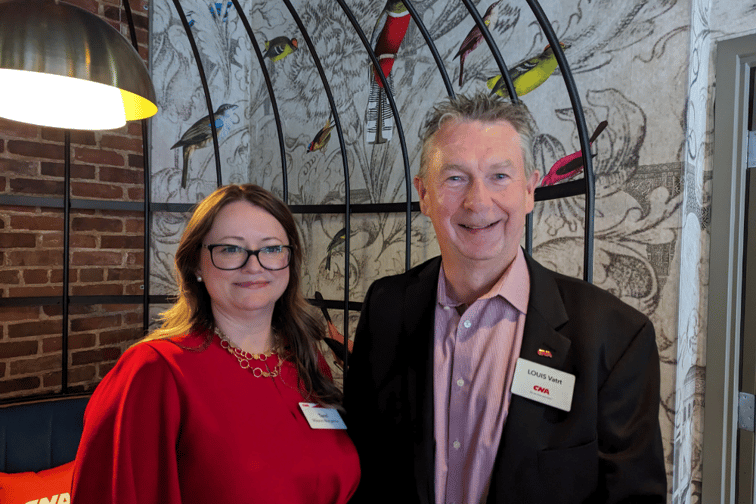

Whether an insured is a real estate investor wrangling with water damage, or an oil and gas company facing cyber pressures and environmental activism, one challenge – namely, talent – has proved near universal with the insurance industry also feeling the impact.
“Talent is a big talking point, probably for all groups – in fact, it doesn’t matter who you’re talking to here, whether it’s someone that does engineering supply, a broker, an insured – it’s a hard market for talent right now with a lot of internal movement coming out of the pandemic,” said CNA Canada vice president, engineered property Louis Vatrt (pictured right), who sat down with Insurance Business along with Terri Mason-Benjamin (pictured left), CNA Canada vice president, marketing & distribution, at RIMS Canada 2023.
Vatrt remarked on the lack of young attendees at RIMS Canada, questioning whether it was due to the demographics of the business or simply that more seasoned employees were inclined to attend. Despite seeing some younger individuals present, it was not to the extent that Vatrt had anticipated.
“The industry as a whole should look towards finding more ways to captivate and nurture young talent. At CNA, we are focused on growth from within, training and developing our talent with clear career paths and progression plans.” Vatrt said.
The need to attract fresh faces has in part added to employers across sectors ramping up how they tackle societal and governance issues.
“There’s a lot going on around ESG and companies’ CSR approaches, and much of this relates back to talent, because these topics are important to new, younger people entering the industry,” said Mason-Benjamin.
“We’ve increased our talent pipeline to align with the Canadian market, participating at events, giving back to our communities, and opening mindsets to career change hires, along with increased visibility at our university partners through co-op and internship opportunities.”
Mason-Benjamin added: “CNA prioritizes non-traditional career growth and encourages talent to think beyond their current role and consider the organization as a whole. For instance, we facilitate movement from finance to underwriting, underwriting to HR, and claims to underwriting, providing numerous opportunities for professional development and fostering a company-wide perspective.”
The talent crisis is just one issue causing insurance concerns for clients, with a hard reinsurance market expected to persist into 2024. With insurers taking on more retention, insureds are facing tightened terms and conditions, pricing upticks, and a capacity crunch.
“There’s the capacity and pricing part of the equation, and the fact that some programs were put together not just in an insurance soft market, but a financial soft market,” Vatrt said. “Now we face increasing interest rates and inflationary pressures - it’s all accumulating.”
Natural catastrophe risk, too, has piled on the pressure.
Last year saw Hurricane Fiona pummel Atlantic Canada, driving over $800 million in insured losses. Months prior, a freak derecho tore through parts of Ontario and Quebec, marking the sixth costliest Canadian natural disaster on record at $1 billion in insured damages.
More recently, flooding in Nova Scotia resulted in an insurance bill that topped $170 million, while summer storms in Alberta and the Prairies saw insurance claims totalling over $300 million.
While some industries, like sawmills that have battled through record wildfire burn this year, may have greater exposure, no sector is immune from the potential impact of a natural catastrophe or smaller weather-driven event, such as urban flooding, on its operations and workforce.
In Vatrt’s words, the reinsurance hard market, talent crisis and weather-related risks have proved a “perfect storm”.
As insureds grapple with emerging challenges, communication and expertise, in addition to adequate coverage provisions, are proving vital across both the large and mid-market spaces.
“Insureds and their respective brokers are looking for carriers with underwriting experience and expertise, who can understand their business, and be creative,” Mason-Benjamin said. “They want carrier partners who look for solutions - rather than simply offering insurance products.
“Responsiveness is key to building lasting partnerships. The world is moving so much more quickly these days than ever before; businesses have to keep up and that means their insurance carriers have to keep up as well.”
